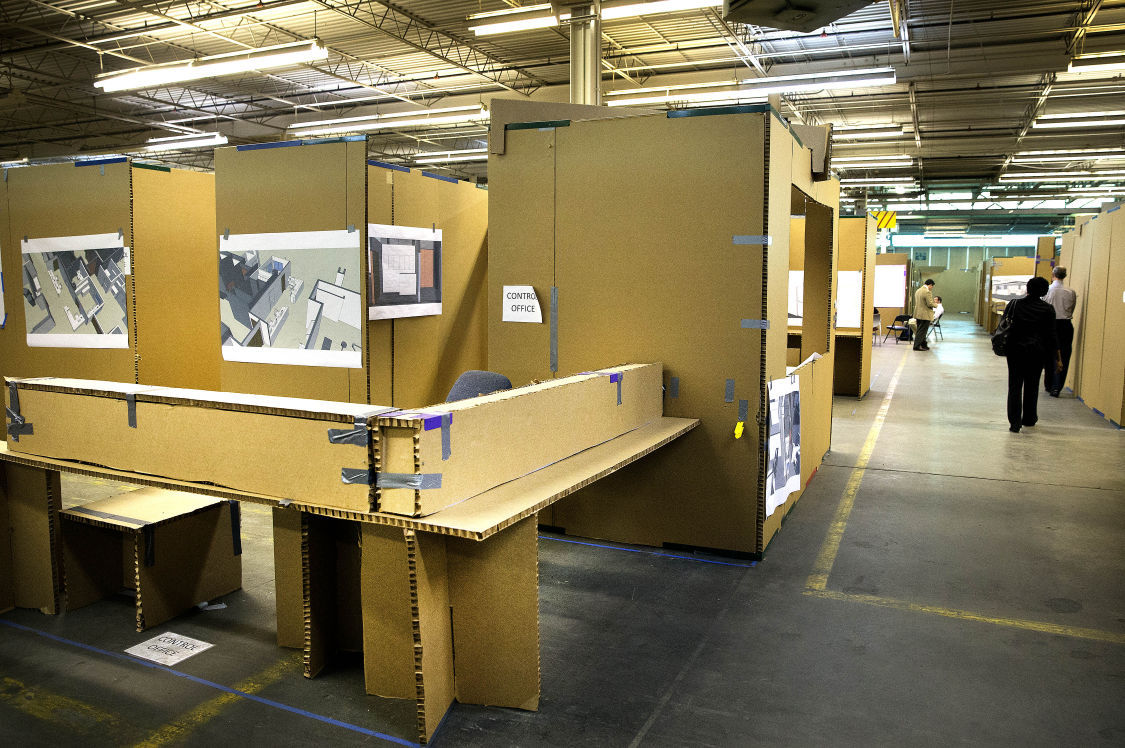
Image Credit: Lynn Hey/ News & Record
This is the second post in a series about tech-enabled pre-occupancy evaluations, opening up a new world of possibilities for AEC.
Working Digitally Removes Physical Costs and Constraints
In an industry where project bids can be fierce, and profit margins tight, effective use of technology can be a force multiplier to staying on time and on budget - even under less than ideal conditions like those we find ourselves in this year.
Shifting to digital and virtual design review, and leveraging technology like VR that allows you to do so at scale, is a game changer in a number of ways. For one - outside of VR, there is no way to instantly and immersively walk through projects at 1:1 scale early in the phases of design development.
BIM + VR makes pre-occupancy evaluations accessible and experiential in ways never before realized. They can be approached early on with an attitude akin to rapid prototyping. This is a huge competitive advantage in industries like restaurants and retail, where competition is stiff. They can swiftly prototype and hone their spaces and refine the brand experience and touchpoints of all types, directly alongside their evolving customer base.
When working virtually, real-world constraints such as space, labor, and materials - along with their associated costs - are nullified. It doesn’t cost anything extra to digitally A/B test design options, nor does it take up any extra resources or time. In VR, with the click of a button, you can showcase limitless combinations and variations of an idea or project - and any and all relevant stakeholders can experience it as if it were already built, and they were there. Without geographical constraints, virtual review and collaboration can also help get a broader and more accurate survey sample of potential customers and end users.
VR swings the door wide open, ushering in faster and more powerful ways to understand options and iterations, without the sustainability nightmare of having to build out mockups.
A Sustainability No-Brainer
Cardboard, drywall, warehouse space, carpeting, skilled trades. The amount of effort and costs incurred when putting together a physical mock up at full scale are hard to swallow, especially when sustainability and reducing waste are a chief concern of a growing number of conscious consumers. Companies making an active effort to align themselves with their customers values is more important than ever in an increasingly competitive space.
For all things eco-friendly, taking pre-occupancy evaluations virtual is hands down a winner. In addition to eliminating the massive amounts of waste of physical materials used for the mockups that would need to be disposed of, there are fringe benefits. Reduced need to travel to a physical site cuts down on fuel emissions and other transportation costs. In a pandemic, these sorts of in-person evaluations may not be practical or possible, but, long term, taking proper precautions would undoubtedly produce waste as well as additional costs.
Sustainability and variety of options are often at odds with each other. This doesn’t hold true in the context of using VR for design review, where different space plans, paint samples, FF&E choices, balusters and railings (the list goes on) can be intensely examined and evaluated with a sense of scale and realism difficult or costly to achieve under real world conditions. So, showcasing options outside of a VR walkthrough isn’t even a good experience, nor is it practical - especially right now.
Virtual pre-occupancy evaluations are a marked improvement on prevailing industry wide practices, which begs the question: given that the benefits are high, and the costs and downsides are low, what is to prevent this from becoming standard operating procedure? Which begs another question: when it comes to modern technology in the AEC space, is it time to adapt or die?
Minimize Avoidable Costs and Maximize Value
We live in an instant gratification society in which people expect efficient delivery of high-value products and services. The internet and cloud computing has led to value and efficiency being subconsciously expected. The expectation of a seamless customer experience that empowers confident decision making and buy-in is more of an opportunity than a burden for those who rise to the challenge. The actual, and perceived, value of the project delivery allow for higher fees, and thus better overall margins.
Turnkey solutions like Prospect by IrisVR allow professionals to flip the script on what modern project delivery looks like, and how to think about value and ROI. Ease of use, scalability, overhead costs and feature sets need to be well suited to the needs of a team and project - minimizing change management, or any possible friction therein. Human-centered design principles and policies drive innovation and deliver value to those who are directly impacted by a space - putting needs, wants, utility, and invaluable end-user insight at the core of decision-making throughout a project. This helps avoid unnecessary costs of change orders and rework discovered too late, while prioritizing the experience provided by the designed and built space.
There are IrisVR customers currently navigating this uncertain business climate with leaner teams, seeing their projects moving along more efficiently than ever before. There are clear advantages of bringing clients, designers, and trades together to design, review, and collaborate digitally, well before any ground breaking ceremony or ribbon cutting.
What could your current project stand to gain from a pre-occupancy evaluation? Stay tuned for the next post in the series that delves deeper into the advantages that AEC teams gain from these sorts of evaluations. Ready to dive into a VR-enabled pre-occupancy evaluation with a current project? Reach out to our team of experts who can help get you started.
.png?width=212&name=Prospect%20by%20IrisVR%20Black%20(1).png)
